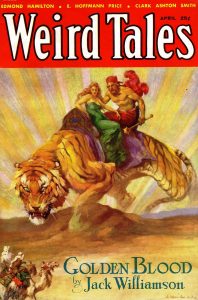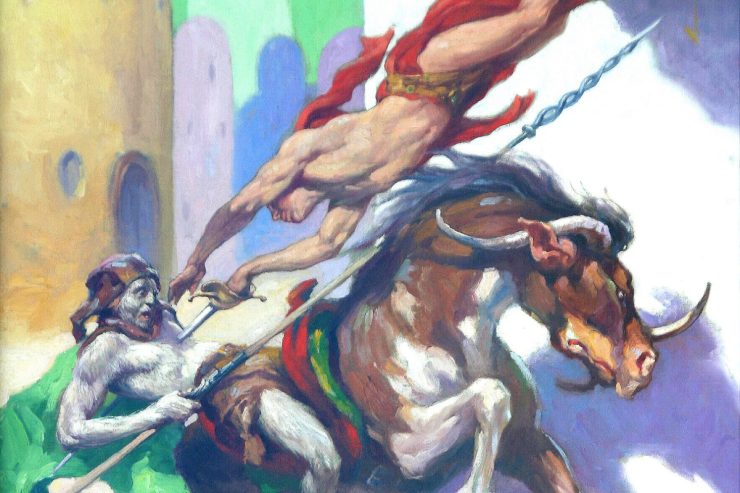Pulp magazines have influenced writers, artists, film directors, software developers, and countless others over the years. Our “Pulp History” articles focus on the rough-paper writers, editors, publishers, and artists who have inspired and continue to inspire the creators of the world’s popular culture.
 When one thinks of Weird Tales, the big three come to mind — H. P. Lovecraft, Robert E. Howard, and Clark Ashton Smith.
When one thinks of Weird Tales, the big three come to mind — H. P. Lovecraft, Robert E. Howard, and Clark Ashton Smith.
It goes without saying that “The Unique Magazine” published some of the best fantasy and supernatural fiction of the pulp era or, for that matter, of any era.
But Weird Tales also featured some of the finest cover art of the pulps, particularly the work of Margaret Brundage, Virgil Finlay, Hannes Bok, and J. Allen St. John. The latter painted nine covers for the magazine and contributed 16 interior illustrations.
James Allen St. John was born on October 1, 1872 in Chicago, Illinois. The son of a medical doctor and a fine artist, St. John’s earliest memories were of his mother’s art studio “and the eyes of her portraits following me about the place.”
In 1880, Susan Hely St. John traveled to Paris to further her studies. She was accompanied by her son who rambled “at will through the Louvre, the Luxembourg, and the countless quaint and charming corners of the unfashionable parts of the city so dear to all dreamers.”
According to the artist, he began to draw and paint before he could read and write. Rejecting his father’s entreaties to enter the business world, the young St. John was sent to his uncle’s ranch in California to learn “to ride and to shoot, and to become a cowboy, pure and simple.” Instead, the strong-willed boy took up with Eugene Torrey, a landscape artist based in Los Angeles. He would spend the next three years studying under Torrey.
At the age of nineteen, St. John returned to live with his parents in New York City and to study at the Art Students League. By 1898, he had gained a reputation as a portraitist. He also began illustrating professionally for magazines and newspapers such as The Delineator, Harper’s New Monthly Magazine, The New York Herald, Red Book Magazine, Woman’s World, Youth’s Companion, and for the book trade.
In 1903, St. John returned to Chicago to help care for his ailing father. During this period, he wrote and illustrated a children’s book entitled The Face in the Pool. It was published in 1905 by A. C. McClurg and Company, gaining the young artist an introduction to the publisher. Later that same year, he married Ellen May Munger who would later serve as a model for his fantastic paintings.
After further study in Europe, St. John returned to Chicago in 1910 to live with his widowed mother. In 1912, he began illustrating books for A. C. McClurg, starting with L. Curry Morton’s The Hero and the Man. At the same time, a new writer named Edgar Rice Burroughs was gaining a reputation in All-Story Magazine. “Under the Moons of Mars” appeared in early 1912, followed by “Tarzan of the Apes,” published in its entirety in the October 1912 issue of the Munsey magazine. A. C. McClurg would begin publishing Burroughs’ novels in book form beginning with Tarzan of the Apes in 1914.
Although McClurg decided to use N. C. Wyeth’s cover painting for The Return of Tarzan in 1915, they asked St. John to contribute twenty-six chapter headings to illustrate the book. Beginning with the third novel in the series — The Beasts of Tarzan — St. John would contribute all of the interior art, as well as the full-color dust jacket. The artist would go on to contribute artwork for 36 Edgar Rice Burroughs books, including fourteen dust jackets to the Tarzan series.

Edgar Rice Burroughs wrote in a letter dated May 18, 1920:
I think you visualize the characters and scenes precisely as I did. If I could do the sort of work you do I would not change a line in any of the drawings. . . . Each picture reflects the thought and interest and labor that were expended upon it, and so I wish not only to congratulate you but to thank you for helping to make a book which would sell on the strength of the illustrations alone, regardless of the text.
 Over a long career, J. Allen St. John would illustrate many other books, including work by Robert Ames Bennet, Ray Cummings, Oscar J. Friend, Edgar A. Guest, Robert J. Horton, Otis Adelbert Kline, Clarence E. Mulford, George Ogden, Kenneth Perkins, Robert Pinkerton, Charles Alden Selzer, Jack Williamson, and George F. Worts. He would contribute cover art as well as interior illustrations to such magazines as Amazing Stories, Blue Book, The Boy’s World, Child Life Magazine, Fantastic Adventures, The Green Book Magazine, Magic Carpet Magazine, Mammoth Adventure, Mystic Magazine, Oriental Stories, Other Worlds Science Stories, The Red Book Magazine, Weird Tales, and Young People’s Weekly. He was also an instructor at the Art Institute of Chicago and later, the American Academy of Art. He continued to teach until a year before his death in 1957 at the age of 84.
Over a long career, J. Allen St. John would illustrate many other books, including work by Robert Ames Bennet, Ray Cummings, Oscar J. Friend, Edgar A. Guest, Robert J. Horton, Otis Adelbert Kline, Clarence E. Mulford, George Ogden, Kenneth Perkins, Robert Pinkerton, Charles Alden Selzer, Jack Williamson, and George F. Worts. He would contribute cover art as well as interior illustrations to such magazines as Amazing Stories, Blue Book, The Boy’s World, Child Life Magazine, Fantastic Adventures, The Green Book Magazine, Magic Carpet Magazine, Mammoth Adventure, Mystic Magazine, Oriental Stories, Other Worlds Science Stories, The Red Book Magazine, Weird Tales, and Young People’s Weekly. He was also an instructor at the Art Institute of Chicago and later, the American Academy of Art. He continued to teach until a year before his death in 1957 at the age of 84.
One hundred and fifty years old this week, J. Allen St. John inspired such artists as Robert Abbett, James Bama, Frank Frazetta, Jeffrey Catherine Jones, Roy G. Krenkel, Harold W. McCauley, Russ Manning, William Stout, and Mark Wheatley. A great illustrator, St. John was, in short, a master of adventure and the fantastic.
We hope you’ll join us from August 3 – 6 at the DoubleTree by Hilton Hotel Pittsburgh – Cranberry in Mars, Pennsylvania for PulpFest 2023 and our second ERBFest. We’ll be celebrating the centennials of both Weird Tales and Edgar Rice Burroughs, Inc. and much more at our conventions. Included in our programming will be a salute to the master of adventure and the fantastic, J. Allen St. John, by David Saunders, winner of the 2016 Lamont Award and the foremost scholar of American pulp artists.
Our featured image is J. Allen St. John’s cover painting for the January 1933 issue of Weird Tales. The painting illustrates a scene from the cover story, Otis Adelbert Kline’s “Buccaneers of Venus.” The artwork is from the collection of Doug Ellis and Deb Fulton.
Arnie Fenner — who, with his wife, Cathy Fenner, edits the annual Spectrum: The Best in Contemporary Fantastic Art — has called J. Allen St. John’s cover painting for the April 1933 issue of Weird Tales “. . . not only a perfect symbol of a bygone era in American entertainment but also . . . a wonderful example of how a painting can transcend its original intent and venue to become a timeless work of Fine Art.” The painting illustrates a scene from Jack Williamson’s serialized novel, “Golden Blood.”
The Beasts of Tarzan was the first of many St. John cover paintings illustrating the work of Edgar Rice Burroughs. The book was published in March of 1916 by A. C. McClurg and Company. It was one of seven wraparound dust jackets that the artist produced for Burroughs novels. The image above is based on an 11 x 17-inch print restored and produced by Phil Normand of Recoverings.
J. Allen St. John’s cover art for the January 1928 issue of The Illustrated Blue Book Magazine illustrates the second segment of Edgar Rice Burroughs’ serialized novel, “Tarzan, Lord of the Jungle.” The story ran in six segments dated December 1927 through May 1928. It was reprinted in book form later that same year by A. C. McClurg.







